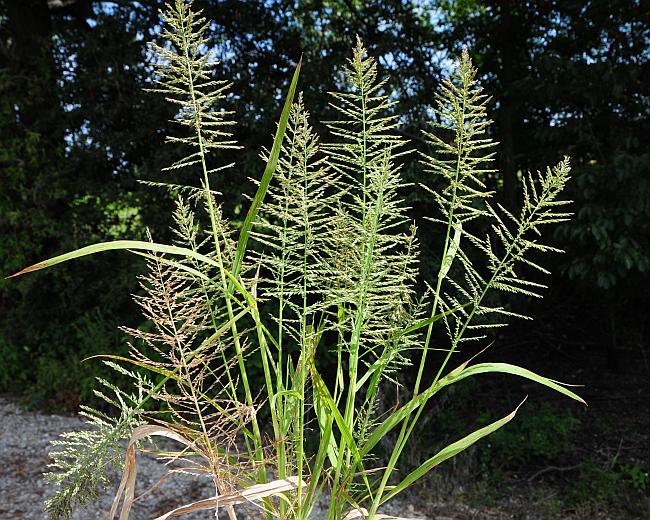Leptochloa panicoides (J. Presl) Hitchc.
Amazon Sprangletop

Native
CC = 5
CW = -3
MOC = 15
© SRTurner
Leptochloa panicoides (J. Presl) Hitchc.Amazon Sprangletop | |
 |
Native CC = 5 CW = -3 MOC = 15 |
© SRTurner |
|
Family - Poaceae/Eragrostideae Habit - Annual grass, forming tufts. Stem - Flowering stems erect or ascending, to 1.1 m, circular in cross section, glabrous.
Leaves - Leaf sheaths rounded on the back or the lowermost keeled, glabrous or rarely slightly roughened, the ligule 2-4 mm long, uneven along the margin. Leaf blades 4-20 cm long, 4-10 mm wide, glabrous or somewhat roughened, especially on the margins. Ligule - No info. yet
Inflorescence - Numerous (20-90) spikelike racemes in a conical cluster 12-35 cm long, these mostly alternate along the inflorescence axis, 2-8 cm long.
Spikelets - 3.5-5.0 mm long, moderately flattened, with 4-7 florets. Lower glume 0.9-1.9 mm long, narrowly lanceolate, sharply pointed at the tip. Upper glume 1.6-2.3 mm long, ovate, sharply pointed at the tip. Lemmas 2.2-3.0 mm long, narrowly elliptic to ovate, sharply pointed at the tip, sometimes minutely notched, awnless or with a minute, sharp point, keeled. Anthers 0.6-0.8 mm long.
Fruits - Fruits 1.1-1.4 mm long, elliptic to obovate in outline, slightly flattened. Flowering - August - October. Habitat - Bottomland forests, streambanks, ditches, rice fields, moist open disturbed areas. Origin - Native to the U.S. Lookalikes - Other members of the genus. Other info. - This species is not particularly common in Missouri, having been collected mostly from counties in the Bootheel and a few bordering the large rivers. Its range continues down the Mississippi River valley, through Arkansas, Alabama, and Louisiana, and into Mexico and South America. Photographs taken at Catawissa Conservation Area, Franklin County, MO, 9-10-2017, and at Otter Slough Conservation Area, Stoddard County, MO, 9-10-2019 (SRTurner). |